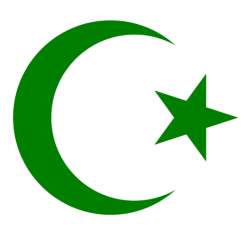Star and Crescent

A star (or stars) and crescent featuring in some combination form the basis of symbols widely found across the ancient world, with examples attested from the Eastern Mediterranean and Central Asia.
The early Muslim community did not have a symbol. During the time of prophet Muhammad, Islamic armies and caravans flew simple solid-coloured flags (generally black, green, or white) for identification purposes. In later generations, the Muslim leaders continued to use a simple black, white, or green flag with no markings, writing, or symbolism on it.
During the 19th century, it represented the Ottoman Empire, figuring on the Ottoman flag from 1793. The Ottoman flag of 1844 with a white "Ay-yıldız" (Turkish for star-crescent) on a red background continues to be in use as the flag of the Republic of Turkey. Other successor states of the Ottoman empire also used the symbol, including Libya (1951–1969 and after 2011), Tunisia (1956) and Algeria (1958).
The same symbol was used in other national flags introduced during the 20th century, including the flags of Azerbaijan (1918), Pakistan (1947), Malaysia (1948), Mauritania (1959).
During the 1950s to 1960s, the symbol was re-interpreted as symbolic of Islam or the Muslim community.
By the 1970s, this symbolism was embraced by movements of Arab nationalism or Islamism, such as the proposed Arab Islamic Republic (1974) and the American Nation of Islam (1973).
In Unicode, a "star and crescent" symbol is encoded at U+262A: ☪
© Symbols.com
